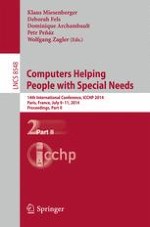The two-volume set LNCS 8547 and 8548 constitutes the refereed proceedings of the 14th International Conference on Computers Helping People with Special Needs, ICCHP 2014, held in Paris, France, in July 2014. The 132 revised full papers and 55 short papers presented were carefully reviewed and selected from 362 submissions. The papers included in the second volume are organized in the following topical sections: tactile graphics and models for blind people and recognition of shapes by touch; mobility support and accessible tourism; smart and assistive environments: ambient assisted living (AAL); text entry for accessible computing; people with motor and mobility disabilities: AT and accessibility; assistive technology: service and practice; ICT-based learning technologies for disabled and non-disabled people; universal learning design: methodology; universal learning design: hearing impaired and deaf people; universal learning design: sign language in education; sign language transcription, recognition and generation; universal learning design: accessibility and AT; differentiation, individualisation and influencing factors in ICT-assisted learning for people with special needs; developing accessible teaching and learning materials within a user centred design framework and using mobile technologies to support individuals with special needs in educational environments.
